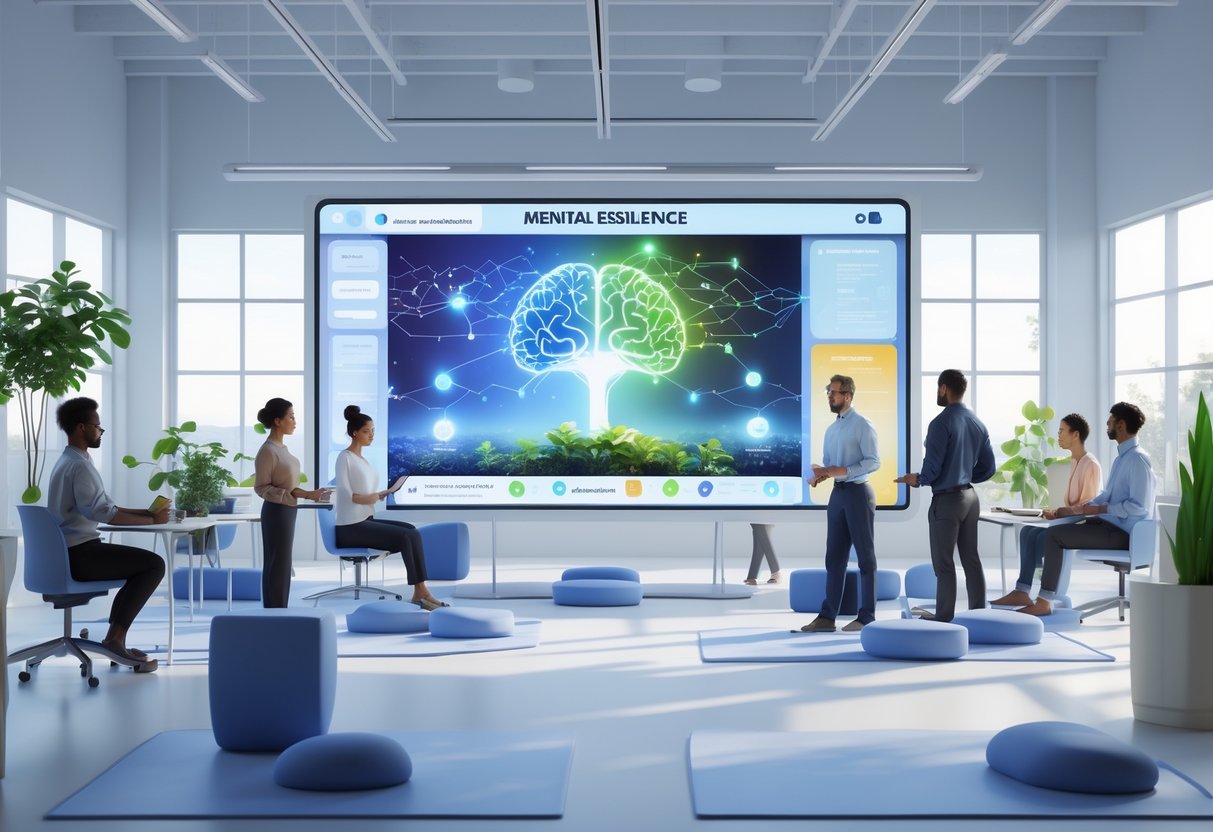Mental Resilience Training: Core Skills, Strategies & Benefits
Updated On: October 24, 2025 by Aaron Connolly
Understanding Mental Resilience Training
Mental resilience training helps you learn how to bounce back from setbacks and adapt when gaming gets rough. Instead of just encouraging you to toughen up, it uses proven methods to build your mental strength in a way that’s a bit different from just being “mentally tough.”
What Is Mental Resilience?
Mental resilience is basically your ability to handle stress, setbacks, and challenges without falling apart. It’s a skill, almost like a muscle, and you can make it stronger with practice.
In esports, this often means keeping your cool when the pressure ramps up. It also helps you get through losing a big match or dealing with harsh criticism online.
Key signs of strong mental resilience include:
- Staying focused under pressure
- Learning from losses quickly
- Managing tilt and frustration
- Adapting to new strategies
- Keeping your confidence after a rough performance
People with low resilience usually feel anxious, struggle to sleep, or just want to quit after a defeat. Some even start to avoid competition altogether.
Researchers have found that nobody is born with perfect resilience. You can actually train these skills with the right approach.
The Science Behind Resilience Training
Scientists have dug into how our brains react to stress and challenge. They figured out that certain training methods can change how we think and respond.
Resilience training teaches you:
- New ways of thinking that help you stay positive
- Breathing techniques to manage stress
- Problem-solving skills for tough spots
- How to see setbacks as learning moments
People who finish resilience training usually handle stress better. They bounce back faster from tough experiences and perform better when it matters.
You start by practising these skills in safe, low-pressure situations. Over time, you use them in bigger challenges, like tournament games.
Your brain actually builds new connections with this kind of practice. Eventually, resilient thinking feels natural, not forced.
Mental Resilience vs Mental Toughness
Mental resilience and mental toughness sound similar, but they’re pretty different in practice. Knowing the difference can help you pick the right training.
Mental toughness is all about pushing through pain and never quitting. You just keep going, no matter what.
Mental resilience is more about adapting and bouncing back. Instead of just powering through, you figure out how to solve problems and come out stronger.
| Mental Toughness | Mental Resilience |
|---|---|
| Push through everything | Adapt and adjust |
| Ignore emotions | Manage emotions well |
| Never show weakness | Learn from setbacks |
| Rigid approach | Flexible thinking |
In competitive gaming, toughness might mean grinding for 12 hours straight. Resilience helps you know when to step back, rest, and return stronger.
Both have their uses, but resilience training gives you more ways to handle whatever comes your way.
Key Components of Mental Resilience
Mental resilience stands on three main skills that work together. You need to understand your emotions, adapt to change, and believe you can grow with effort.
Emotional Intelligence
Emotional intelligence is really the base of mental resilience. It’s about recognising your feelings and handling them well when things get tough.
Self-awareness comes first. You have to notice when stress creeps in or when you start to feel overloaded.
Emotional regulation is next. Strong players manage their reactions instead of letting emotions take over. They might take a few deep breaths, count to ten, or step away for a minute.
Key emotional intelligence skills include:
- Recognising triggers before things spiral
- Managing stress with healthy outlets
- Reading social cues from teammates and opponents
- Staying calm even when things go sideways
Try keeping a mood diary. Just jot down how you feel before and after gaming. You’ll probably start to see patterns in your emotional responses.
Empathy matters too. When you understand how others feel, you build stronger teams and communicate better during matches.
Adaptability
Adaptability is all about adjusting when things change. Gaming never stands still—there are always new patches, strategies, and team setups.
Flexibility helps you deal with surprises. When your main plan fails, you need a backup. Good players think fast and try new things.
Mental adaptability includes:
- Learning from mistakes instead of just feeling bad about them
- Trying new tactics when old ones don’t work
- Staying open to feedback from coaches and teammates
- Embracing change instead of fighting it
Perseverance keeps you in the game when things get rough. Resilient players bounce back from losses and keep practising.
You can build adaptability by playing different roles or game modes. It forces you to think differently and pick up new skills.
Problem-solving gets better with practice, too. Set small challenges for yourself. Try winning with a weird strategy or focus on fixing a weak spot in your gameplay.
Growth Mindset
A growth mindset means you believe you can get better with effort and practice. This way of thinking builds real resilience over time.
People with a fixed mindset think talent is set in stone. They tend to give up when things get tough and avoid situations that might show their weaknesses.
Players with a growth mindset see challenges as chances to improve. They work harder when things get rough, ask for help, and learn from criticism.
Growth mindset helps you:
- See failures as learning moments
- Look for challenges that stretch your skills
- Welcome feedback from others
- Celebrate progress instead of perfection
You can start shifting your mindset by changing how you talk to yourself. Swap “I’m bad at this” for “I’m still learning this.” Or try “I can’t do it yet” instead of “I can’t do it.”
Praising effort works better than praising talent. Focus on the work you put in, not just natural ability. That builds confidence in your ability to improve.
Set learning goals along with performance goals. Aim to master new skills or understand the game better. That way, you stay motivated even when you’re losing.
Mental Resilience and Mental Health
Mental resilience training can make a real difference in depression, anxiety, and overall psychological wellbeing. Research shows that structured programmes using meditation, cognitive techniques, and stress management can reduce symptoms and help you build long-term coping skills.
Impact on Depression
Mental resilience training gives you practical tools for managing depression. Studies say that eight-week programmes can boost global mental health scores in a big way.
When you combine mindfulness practices with cognitive restructuring, you break the cycle of negative thoughts. You learn to spot automatic negative thinking and swap it for a more balanced view.
Key techniques include:
- Thought monitoring: Keeping track of negative patterns
- Cognitive reappraisal: Challenging your own distorted thoughts
- Mindfulness meditation: Staying present instead of getting stuck in your head
- Self-compassion exercises: Cutting yourself some slack
People often notice better moods within a few weeks of starting. Mental health professionals often suggest resilience programmes as part of depression treatment.
The structure helps you build daily habits. These stick with you and become go-to tools when things get tough.
Managing Anxiety
Resilience training works especially well for anxiety. Focusing on stress management and breathing exercises can give you relief right when you need it.
Mind-body techniques form the heart of anxiety management:
- Breath awareness meditation: Calms your nervous system
- Progressive muscle relaxation: Loosens up physical tension
- Mini-relaxations: Quick stress-busters for busy days
- Body scan exercises: Helps you spot stress signals early
Research backs up these methods—they really do lower stress levels. You learn to catch anxiety before it spirals.
The cognitive side teaches you to tell the difference between real concerns and worries that anxiety creates.
Mental health professionals like these approaches because they’re evidence-based. They add to traditional treatments and give you more active ways to cope.
With regular practice, you get more confident about handling anxiety on your own. You don’t have to lean on avoidance strategies that usually make things worse.
Supporting Overall Wellbeing
Resilience training has ripple effects across your mental health. People often sleep better, feel happier in their relationships, and juggle work and life more easily.
This approach covers:
- Physical health: Better sleep, exercise, and nutrition habits
- Social connections: Improved communication and empathy
- Work satisfaction: Handling job stress with more ease
- Emotional regulation: Noticing and managing your feelings
You’ll often see better job satisfaction and less emotional burnout. Healthcare workers, for example, really benefit from this at work.
The group aspect of training adds extra support. People appreciate connecting with others who get what they’re going through.
Mental health professionals see resilience training as a smart way to prevent problems before they start. Building these skills ahead of time gives you a stronger base for wellbeing.
With long-term practice, you develop real resilience—not just short-term coping tricks. People say they feel more ready to handle whatever life throws at them.
Practical Techniques in Resilience Training
Mental resilience training leans on proven methods to help you recover from setbacks and manage stress better. The most effective strategies include changing negative thought patterns with CBT, building present-moment awareness through mindfulness, and boosting your strengths with positive psychology.
Cognitive Behavioural Therapy Approaches
CBT sits at the heart of many resilience programmes because it teaches you to spot unhelpful thoughts and swap them for more realistic ones.
This technique helps you catch negative spirals before they take over. When you hit a challenge, CBT encourages you to pause and ask, “Is this thought actually true or helpful?”
Key CBT techniques:
- Thought challenging (questioning negative beliefs)
- Behavioural experiments (testing fears in small steps)
- Problem-solving skills training
- Cognitive restructuring (reframing situations)
You’ll often practise these skills with role-play exercises. You might work through scenarios like getting rejected from a job or dealing with conflict.
CBT is practical—you get real tools to use next time, not just talk about problems.
Mindfulness Meditation Methods
Mindfulness meditation builds resilience by training your attention and helping you stay steady under pressure.
Body scan meditation is a good starting point. You focus on different parts of your body, noticing tension but not trying to change it. This helps you get a sense of how stress hits you physically.
Research shows that regular mindfulness changes your brain’s stress response. Even 10-15 minutes a day can make a difference.
Popular mindfulness techniques:
- Breathing exercises (like the 4-7-8 method)
- Walking meditation
- Mindful listening
- Staying present on purpose
Consistency matters more than length. Short, regular sessions beat the occasional marathon.
A lot of people find mindfulness apps helpful for building the habit. Guided meditations are a good way to start before you try silent practice.
Positive Psychology Interventions
Positive psychology is about building mental strength, not just fixing problems. These strategies help you develop resources before trouble hits.
Gratitude practices are among the most researched. Writing down three good things each day helps your brain focus on positives.
Strengths identification means figuring out what you’re naturally good at and using those talents more often. When you play to your strengths, you feel more capable.
Flow activities put you in a state where you’re totally absorbed and time flies. These experiences show you can handle tough challenges.
Acts of kindness actually boost your own wellbeing as well as helping others. Research says helping others increases hope and courage while lowering fear.
A good routine combines daily gratitude journaling with weekly strengths-based activities. This gives you a positive foundation to lean on when life gets hard.
Developing Stress Management Skills

Managing stress isn’t just about reacting in the moment—it’s also about building habits that make you more resilient over time. You need both quick fixes and long-term strategies to really get a handle on all that pressure and anxiety.
Strategies for Stressful Situations
When stress hits, your initial reaction can make all the difference. Breathing exercises, like the 4-7-8 technique, can settle your nerves surprisingly fast. Just breathe in for 4 counts, hold for 7, and let it out for 8.
Immediate Response Strategies:
- Try “mini relaxations”—just 30 seconds of deep breathing
- Challenge your automatic negative thoughts
- Use the STOP method: Stop, Take a breath, Observe, Proceed mindfully
Pay attention to your body. If your shoulders tense up, your jaw tightens, or your heart starts pounding, those are your early warning signs. Catching them early means you can use coping strategies before things spiral.
Cognitive reappraisal helps you see tough situations differently. Instead of thinking, “This is awful,” you might say, “This is tough, but I can handle it.” That small change? It actually lowers stress hormones and helps you think more clearly.
Quick Win: Keep a “coping log” where you jot down stressful moments and what helped most.
Effective Stress-Reduction Techniques
You can build up your stress resistance with regular practice. Meditation, body scans, and mindfulness keep you grounded and stop your mind from running wild about the future.
Proven Stress-Reduction Methods:
- Even five minutes of meditation every day
- Progressive muscle relaxation
- Mindful movement—yoga or just a walk
- Writing down things you’re grateful for
The SMART program combines different techniques and has shown big stress reduction benefits. People who stick with it often sleep better and feel more satisfied at work.
Don’t forget the basics. Good sleep, eating well, and keeping up with friends make it way easier to handle stress. Exercise is a game-changer too—endorphins are real.
Warning: Don’t overwhelm yourself by trying every method at once. Pick one or two and stick with them before adding new ones.
Mix quick fixes with longer-term habits for the best results. That way, you’ll have tools for the moment and the stamina to deal with whatever comes next.
Building and Enhancing Mental Strength

You build mental strength by training your body, boosting your confidence, and practicing perseverance. These pillars work together and create a foundation for success in competitive gaming—or honestly, anything intense.
Role of Physical Exercise
Exercise doesn’t just help your body—it sharpens your mind for gaming. Cardio pumps more blood to your brain, so you can focus better during those long sessions.
Strength training builds mental toughness because you push through discomfort. That grit translates directly to gaming when you’re grinding up the ranks.
Endorphins from exercise fight off stress. Even a 20-minute walk between matches can totally reset your focus.
Quick cardio options for gamers:
- Jog for 10 minutes in the morning
- Do bodyweight circuits while waiting in queue
- Climb stairs between scrims
Weight training teaches patience. You won’t see muscles overnight, just like you won’t rank up instantly.
If you can stick to a workout routine, you can stick to a practice schedule. The discipline carries over.
Boosting Confidence
Confidence in gaming grows from preparation and small wins. Start by mastering a single champion or character before branching out.
Track your stats each week. Noting your aim accuracy, reaction times, or win rates gives you proof of progress.
Set tiny goals during games. Maybe focus on last-hitting for five minutes or landing three skillshots in a row. These little victories add up.
Confidence-building checklist:
- Watch your best plays every week
- Write down three things you improved after each session
- Practice mechanics with aim trainers
- Learn from losses without beating yourself up
Mental rehearsal helps too. Picture yourself nailing that perfect team fight or clutching a round before a big match.
Use positive self-talk. Instead of “I’m terrible,” try “That’s not like me.” It really helps you stay calm and focused.
Perseverance and Endurance
Perseverance is what separates casuals from competitors. You’ll hit losing streaks, deal with toxic teammates, and sometimes feel stuck.
Set up ways to bounce back. If you lose three games in a row, take a 15-minute break and come back refreshed.
Build up your mental endurance by slowly increasing your focused practice time. Start with 30 minutes, then stretch it to two hours over time.
Endurance building techniques:
- Meditate for 10 minutes daily
- Use deep breathing when things get stressful
- Stick to a regular sleep schedule—aim for 7-9 hours
- Drink water every hour
Treat failure as feedback. Every mistake teaches you something about your opponents or yourself.
Keep the long-term in mind. Top players sometimes need months to master new strategies or adapt to changes.
Find practice partners or a coach. Having someone else to answer to keeps you going, even when motivation dips.
Goal Setting for Mental Resilience

Setting goals gives you a roadmap to bounce back from setbacks and build mental strength. It’s all about using a structure that lets you track your progress in a way that actually means something.
SMART Goal Strategies
SMART goals make things clear: Specific, Measurable, Achievable, Relevant, and Time-bound.
When you set resilience goals, focus on specific behaviours. Instead of saying, “I want to be more resilient,” go with, “I’ll do 10 minutes of mindfulness every day for a month.”
Measurable aspects let you see your progress. Maybe you count how often you ask for help or how many times you challenge negative thoughts.
Set goals you can really reach. If they’re too big, you’ll just get discouraged and give up.
Make sure your goals matter to you. Maybe you want to get better at handling work stress or improve your relationships.
Give yourself a deadline. Monthly or quarterly check-ins help you keep moving forward.
Tracking and Measuring Progress
Monitoring your goals turns wishful thinking into measurable growth. You need a way to know if what you’re doing is actually working.
The Mount Sinai Resilience Scale uses 24 items you rate from 0 to 4. Things like, “I confronted my fears directly,” or, “I challenged negative thoughts about myself.”
Track how often you use resilience strategies and how well they work. Doing something isn’t enough—you need to know if it helps.
Weekly reflection sessions let you spot trends. Maybe reaching out for support works best during work stress, while mindfulness helps more with personal stuff.
Charts or apps make your progress visible. Track sleep, exercise, or how quickly you bounce back from tough days.
Celebrate small wins. Progress stacks up over time, and it’s those little improvements that build real resilience.
Structured Resilience Training Programmes

Plenty of structured programmes use evidence-based methods like CBT and positive psychology to boost mental toughness. The trick is finding one that fits your needs and learning style.
Overview of Leading Programmes
Some programmes have really solid reputations. SMART (Stress Management and Resiliency Training) runs as an 8-week interactive course and teaches mind-body techniques in groups.
ERST (Emotional Resilience Skills Training) offers a 10-week course that targets the roots of anxiety, depression, and PTSD. It focuses on proactive coping strategies for mental resilience.
Most programmes mix CBT techniques with positive psychology. You’ll usually find:
- Stress management tools and breathing exercises
- Cognitive restructuring to challenge negative thoughts
- Mindfulness practices for emotional regulation
- Goal-setting strategies for growth
Programmes come in all shapes and sizes. Some are weekly groups, others are one-on-one coaching. You’ll get practical exercises to use right away.
Most last 8-12 weeks, but some do weekend intensives or day-long workshops.
Choosing the Right Programme for You
Think about your biggest stressors before picking a programme. General stress courses are great for everyday pressure, but trauma-focused programmes work better if you’re dealing with something specific.
Consider how you like to learn. Group sessions give you support from peers, while individual coaching is more personal (but pricier).
Check that the programme uses proven methods, like CBT, and avoid anything promising instant results.
Budget matters. Some NHS programmes are free, but private ones can cost anywhere from £200 to £2,000 depending on length and format.
Look at practical stuff too—location, timing, whether it’s online or in person. Some folks get the most out of a mix of both.
Role of Support Systems and Professionals

Support from mental health professionals and peer networks really forms the backbone of resilience training. Trained specialists teach you the skills, while community support keeps you going.
Working with Mental Health Professionals
Mental health professionals guide you through structured programmes and teach practical resilience skills. They use proven approaches like CBT and stress management to build your coping toolkit.
Trained specialists help by:
- Figuring out your unique stress patterns
- Creating a personalised training plan
- Using evidence-based methods like cognitive restructuring
- Tracking your progress and tweaking your plan
Critical Incident Stress Management (CISM) helps people process trauma and prepare for future challenges.
Most professional programmes blend multiple techniques. The SMART Programme, for example, mixes mind-body skills with cognitive tools and lifestyle tweaks. Research shows this combo can really lower stress.
Professional support works best when you have:
- Regular sessions with a qualified expert
- Homework to practice new skills
- Progress checks with standard tools
- Ways to fit new techniques into your daily life
A lot of workplaces now offer professional resilience training. They know that building mental strength takes expert help and structure.
Community and Peer Support Networks
Peer and community support adds emotional stability and practical help. These connections give you a sense of belonging and make it easier to stick with your resilience journey.
Good support systems include:
- Family who get what stresses you out
- Colleagues who face similar challenges
- Friends who nudge you toward healthy habits
- Community groups focused on wellbeing
Studies show strong support networks help people recover faster from mental health struggles. When you have those connections, you bounce back from setbacks more quickly.
To build a solid peer network:
- Stay in touch with supportive people
- Be honest about your struggles and wins
- Encourage each other when things get tough
- Do activities together that boost mental wellness
Community support is especially powerful for marginalised groups. Shared experiences bring understanding and a sense of empowerment you just can’t get alone.
The best setup combines professional guidance with peer support. Experts teach you the skills, and your community keeps you going when things get tough.
Overcoming Challenges and Setbacks

Mental resilience training gives esports players tools to handle the disappointments that always show up in competitive gaming.
The trick is figuring out how to bounce back after losses and keep going, even when your motivation seems to have vanished.
Dealing with Setbacks
Setbacks in esports sting in a unique way. The whole world can watch your mistakes on replay, and chats love to talk about every loss.
Some players fall apart after a rough tournament. Others somehow turn those moments into fuel for growth.
It really comes down to how you process failure.
Try changing the way you talk about losses. Instead of saying, “I played terribly,” say, “I learned three things I need to work on.” This isn’t just about being positive—it’s about building real mental toughness.
Set up a setback review process for yourself:
- Watch replays 24 hours after a loss (not right away)
- Write down 2-3 specific mistakes you made
- Pick one skill to work on in practice
- Give yourself a timeline for improvement (usually 2-4 weeks)
A lot of pro players keep a “failure journal.” It sounds kind of brutal, but it works. You write down what went wrong and what you’ll do differently next time.
The mental challenge isn’t the setback itself. It’s stopping one bad performance from dragging down your confidence for weeks.
Maintaining Motivation Through Difficulty
Motivation disappears fast during losing streaks. We’ve watched promising players quit after dropping several ranks in a row.
Build motivation systems that still work when you really don’t feel like training.
Depending on feelings alone just doesn’t cut it in competitive gaming.
Set up micro-goals during rough patches:
- Focus on one small improvement per session
- Track progress in specific skills, not just wins
- Celebrate learning moments, even in losses
- Connect with teammates who keep you accountable
Make yourself a motivation toolkit for the rough days:
- Watch highlights of your best plays
- Look back at positive feedback from coaches or teammates
- Try 15-minute practice sessions (just start small)
- Switch up your practice routine to keep things interesting
The strongest esports players I’ve met separate their performance from their worth. A bad game doesn’t mean you’re a bad player. A losing streak doesn’t mean you should give up.
Heads up: Don’t compare yourself to pro players when you’re struggling. Their highlight reels won’t help your mindset.
Instead, track your progress against your own past self. Keep notes on how you’ve improved over months, not just days.
Integrating Mental Resilience into Everyday Life

Building mental strength works best when we fit resilience practices into daily routines. It’s easier to start with small, manageable habits and adapt as life changes.
Daily Habits for Long-Term Resilience
Morning Routines for Mental Strength
Kick off your day with 5 minutes of mindful breathing or a quick gratitude reflection.
Jotting down three things you’re grateful for takes less time than scrolling social media.
A simple morning routine can help:
- 5 minutes of deep breathing
- Write one positive intention for the day
- Review your strengths before tough tasks
Evening Reflection Practices
End-of-day habits help you process what happened and build up resilience over time.
Spend 10 minutes reflecting on three good things, even if the day was tough.
Quick tip: Keep a small notebook by your bed for evening reflections.
Building Micro-Habits
Tiny actions, repeated daily, really do add up. Try reframing one negative thought or doing one small act of kindness each day.
Even a week of gratitude journaling can boost your wellbeing for months.
Physical Habits That Support Mental Resilience
Moving your body, sleeping well, and eating right all make a difference.
Even a 10-minute walk can shift your mood when things get rough.
Adapting Strategies Across Life Stages
Resilience in School and University Years
Young adults benefit from purpose-finding exercises and stress management techniques.
You can help students figure out their “ikigai” or reason for being with reflection activities.
Key strategies include:
- Finding meaning in academic challenges
- Building supportive friendships
- Learning to see setbacks as chances to grow
Working Adult Adaptability
Career pressures call for a different approach. Focus on reframing stress and finding purpose in your work.
Heads up: Don’t wait for a crisis to start building resilience habits.
Adults often do well with:
- Purpose check-ins during career transitions
- Mindfulness breaks between meetings
- Identifying strengths for workplace challenges
Later Life Resilience
Older adults face health changes, loss, and big transitions.
Staying connected, volunteering, and finding ways to leave a legacy all help.
Okinawan longevity studies show that having a strong sense of purpose keeps both your mind and body healthier.
The “tend and befriend” approach—helping others and building connections—works especially well.
Frequently Asked Questions

Mental resilience training brings up a lot of questions about exercises, costs, workplace use, programme structure, certification, and the difference between military and civilian approaches.
What exercises can help in improving mental toughness?
You can build mental toughness with exercises that help you handle stress and bounce back from setbacks.
Research shows that certain techniques really do boost psychological resilience over time.
Mindfulness and meditation practices lay the foundation for mental toughness. Start with 5-10 minutes of daily breathing exercises. Focus on your breath and notice stressful thoughts without judging them.
Cognitive reframing exercises let you change negative thought patterns. When you face a challenge, write down three different ways to look at it. This helps you stay flexible under stress.
Progressive muscle relaxation teaches you how to release tension. Tense and relax each muscle group for five seconds, starting at your toes and moving up.
Stress inoculation training exposes you to low-level stress in a controlled way. Practice things like public speaking or cold exposure to build confidence for real-life situations.
Gratitude journalling strengthens positive thinking. Write down three specific things you’re grateful for daily. Studies show this simple habit can boost emotional resilience fast.
Can one undergo resilience training online without any charge?
Plenty of free resilience training options exist online, though the quality can be hit-or-miss.
Some reputable organisations offer no-cost programmes with real value.
The Mayo Clinic has free resilience resources covering emotional, cognitive, physical, and spiritual resilience. You’ll find practical exercises and self-assessment tools there.
NHS mental health resources provide free resilience-building techniques for UK residents, focusing on stress management and emotional regulation.
University psychology departments often publish free research-based resilience materials. Check out resources from Penn State, Harvard, or other major universities.
Mobile apps like Headspace have free tiers with basic resilience exercises. You don’t need to pay for the basics.
YouTube channels run by licensed therapists offer structured resilience training videos. Look for content from certified professionals, not random influencers.
Heads up: Free programmes usually don’t include personalised support or certification. They’re a good starting point, but not a replacement for professional help if you need it.
What are the steps to developing greater resilience in the workplace?
Building resilience at work takes effort from individuals, teams, and leadership. It works best with consistent practice and real support from the top.
Step 1: Assess current resilience levels using surveys or self-evaluation tools. Pinpoint your stress triggers and coping habits at work.
Step 2: Build self-awareness by tracking your emotional responses to workplace challenges. Notice how you react and how long it takes to recover.
Step 3: Develop emotional regulation skills with breathing techniques and mindfulness. Practice these when things are calm, so you’re ready when stress hits.
Step 4: Strengthen social connections by building supportive relationships at work. Social support makes a big difference for resilience.
Step 5: Create meaning and purpose by connecting your daily tasks to bigger organisational goals. Knowing your impact helps you handle tough times.
Step 6: Practice stress management techniques like time management, setting boundaries, and prioritising. These skills help prevent overwhelm.
Step 7: Use recovery practices—get enough sleep, exercise, and take breaks between intense work periods. Physical wellness supports mental strength.
What does a typical resilience training programme entail?
Resilience training programmes usually last 4-12 weeks and cover core psychological skills with hands-on exercises.
Week 1-2: Foundation building introduces resilience concepts, self-assessment, and goal setting. You’ll learn about self-awareness, mindfulness, self-care, positive relationships, and purpose.
Week 3-4: Cognitive skills training helps you spot and change negative thinking. You’ll practice cognitive reframing, stop catastrophic thinking, and build optimism.
Week 5-6: Emotional regulation covers stress management and emotional awareness. You’ll work on mindfulness, breathing, and naming your emotions.
Week 7-8: Social connection building focuses on relationships and communication. Group exercises help you build a support network.
Week 9-10: Meaning and purpose exploration helps you find your values and connect them to daily life.
Week 11-12: Integration and maintenance is about making habits stick. You’ll create a personal resilience plan and practice relapse prevention.
Sessions usually run 90-120 minutes, with homework between meetings. Groups of 8-15 work best for interaction.
Are there any certifications available for becoming a trainer in resilience?
Several organisations offer resilience trainer certifications, but standards vary a lot.
There’s no single body that regulates these qualifications.
Master Resilience Training (MRT) comes from the US Army and the University of Pennsylvania. This 10-day course mostly serves military personnel, but some civilians get in.
American Psychological Association shares guidelines for resilience training but doesn’t offer certification. They recommend trainers have a mental health background or supervised experience.
Commercial training companies like Penn Resilience Programme and Road Back Program offer certification. These usually require 2-5 days of training plus some supervised practice.
Requirements differ by programme, but often include:
- Background in mental health, education, or related field
- 20-40 hours of training
- Supervised practice sessions
- Ongoing education
Heads up: No standard criteria exist for resilience trainer qualifications right now. Research programmes carefully and check trainer credentials.
Costs range from £500-£3,000 for certification. Some programmes charge extra for materials or supervision.
How does resilience training in the military differ from civilian programmes?
Military resilience training goes after unique stressors—think combat exposure, deployment separation, and life-threatening situations. These programmes really zero in on tactical applications, not just general life skills.
The backbone of military resilience training is something called Comprehensive Soldier Fitness. It aims to build up physical, emotional, social, spiritual, and family resilience all at once.
Master Resilience Training takes a different approach from what you usually see in civilian life. Instead of weekly sessions, it packs everything into a 10-day intensive. Military trainers, often noncommissioned officers, lead these sessions—not mental health professionals.
Content focus differs significantly between military and civilian approaches. Military programmes emphasise:

